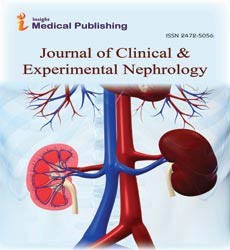Dialysis and Kidney Health: Bridging the Gap in Renal Failure
Levi William
Department of Medicine, University of Florida College of Medicine, Florida, USA
Published Date: 2024-12-11DOI10.36648/2472-5056.9.6.288
Levi William*
1Department of Medicine, University of Florida College of Medicine, Florida, USA
- *Corresponding Author:
- Levi William,
Department of Medicine, University of Florida College of Medicine, Florida, USA
E-mail: williamlevi@ l.eu
Received date: November 26, 2024, Manuscript No. IPJCEN-24-19997; Editor assigned date: November 30, 2024, PreQC No. IPJCEN-24-19997 (PQ); Reviewed date: December 13, 2024, QC No. IIPJCEN-24-19997; Revised date: December 20, 2024, Manuscript No. IPJCEN-24-19997 (R); Published date: December 27, 2024, DOI: 10.36648/2472-5056.9.6.288
Citation: William L (2024) Dialysis and Kidney Health: Bridging the Gap in Renal Failure. J Clin Exp Nephrol Vol.9 No.6: 288.
Description
Dialysis is a medical treatment that performs the function of the kidneys when they can no longer carry out their vital tasks. Kidneys are responsible for filtering waste products, excess fluids and balancing electrolytes in the body. However, in cases of kidney failure, these functions are compromised and dialysis becomes an essential treatment for maintaining life and improving quality of life. Hemodialysis is the most common form of dialysis, accounting for the majority of dialysis treatments worldwide. It involves using a machine, known as a dialyzer, to filter the blood outside of the body. The blood is drawn from the patient’s body through a needle inserted into a blood vessel, typically in the arm. The dialyzer, also referred to as an artificial kidney, removes waste products and excess fluids from the blood, which are then disposed of through the dialysate fluid. Once the blood is filtered, it is returned to the body via another needle. This process typically takes around three to five hours and is usually performed three times a week. Hemodialysis can be done in a hospital or dialysis center, although some patients opt for home hemodialysis if they are well enough and have the necessary support and equipment. While hemodialysis is effective in removing waste and fluid, it is not a perfect substitute for natural kidney function. Patients undergoing hemodialysis may experience fluctuations in blood pressure, fatigue and other complications related to the dialysis process. Additionally, because the treatment does not restore kidney function, it is usually required for life or until a kidney transplant becomes available.
Peritoneal dialysis
Peritoneal Dialysis (PD) is an alternative to hemodialysis that uses the lining of the abdomen, known as the peritoneum, as a natural filter. In this procedure, a sterile solution is introduced into the peritoneal cavity via a catheter that is surgically inserted into the abdomen. The solution remains in the abdomen for a prescribed period, during which the waste products and excess fluids pass through the peritoneum into the dialysate. After the appropriate dwell time, the used dialysate is drained out of the abdomen and replaced with fresh solution. One of the significant advantages of peritoneal dialysis over hemodialysis is that it can be done at home, which offers patients greater flexibility and independence. Additionally, it is a gentler treatment, as it allows for a more continuous form of dialysis, mimicking the natural function of kidneys. However, peritoneal dialysis also carries risks, such as infections and patients must be diligent about hygiene to prevent complications.
The role of dialysis in kidney failure
Dialysis is not a cure for kidney failure but rather a means of managing its symptoms and improving the quality of life for patients who have lost most or all of their kidney function. In cases of Acute Kidney Injury (AKI), dialysis may be a temporary measure to help the kidneys recover, while in Chronic Kidney Disease (CKD), dialysis becomes a long-term solution for those who progress to End-Stage Renal Disease (ESRD).
The decision to begin dialysis is usually made based on a patient’s kidney function, as measured by blood tests like serum creatinine and Glomerular Filtration Rate (GFR). Symptoms such as swelling, fatigue, shortness of breath and electrolyte imbalances can also indicate that dialysis is necessary. Once a patient begins dialysis, they typically require close monitoring by healthcare professionals to ensure the treatment is effective and to manage any potential complications. In many cases, dialysis is needed until a kidney transplant becomes available. A kidney transplant offers the best potential for a cure for end-stage kidney failure, as it restores kidney function to normal levels. However, not all patients are candidates for a transplant due to factors such as age, comorbidities and lack of a suitable donor organ. In these cases, dialysis remains the primary treatment option. In conclusion, dialysis plays a vital role in managing kidney failure, offering patients a chance to survive and maintain a good quality of life. While it is not a cure, it provides vital support for individuals with end-stage renal disease and can serve as a bridge to a kidney transplant or future innovations in kidney treatment. Despite the challenges it presents, dialysis remains a life-saving therapy that has helped millions of patients around the world.
Open Access Journals
- Aquaculture & Veterinary Science
- Chemistry & Chemical Sciences
- Clinical Sciences
- Engineering
- General Science
- Genetics & Molecular Biology
- Health Care & Nursing
- Immunology & Microbiology
- Materials Science
- Mathematics & Physics
- Medical Sciences
- Neurology & Psychiatry
- Oncology & Cancer Science
- Pharmaceutical Sciences
